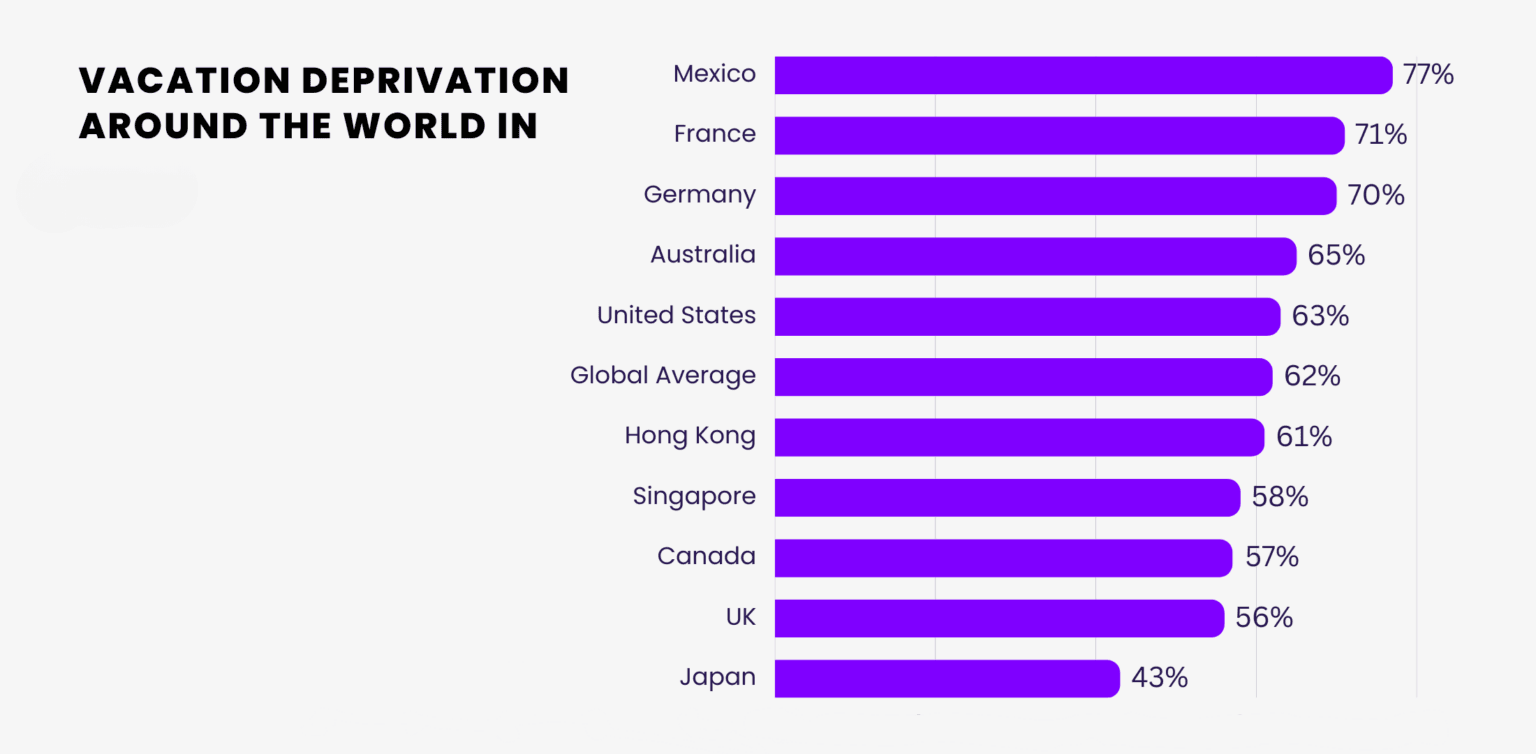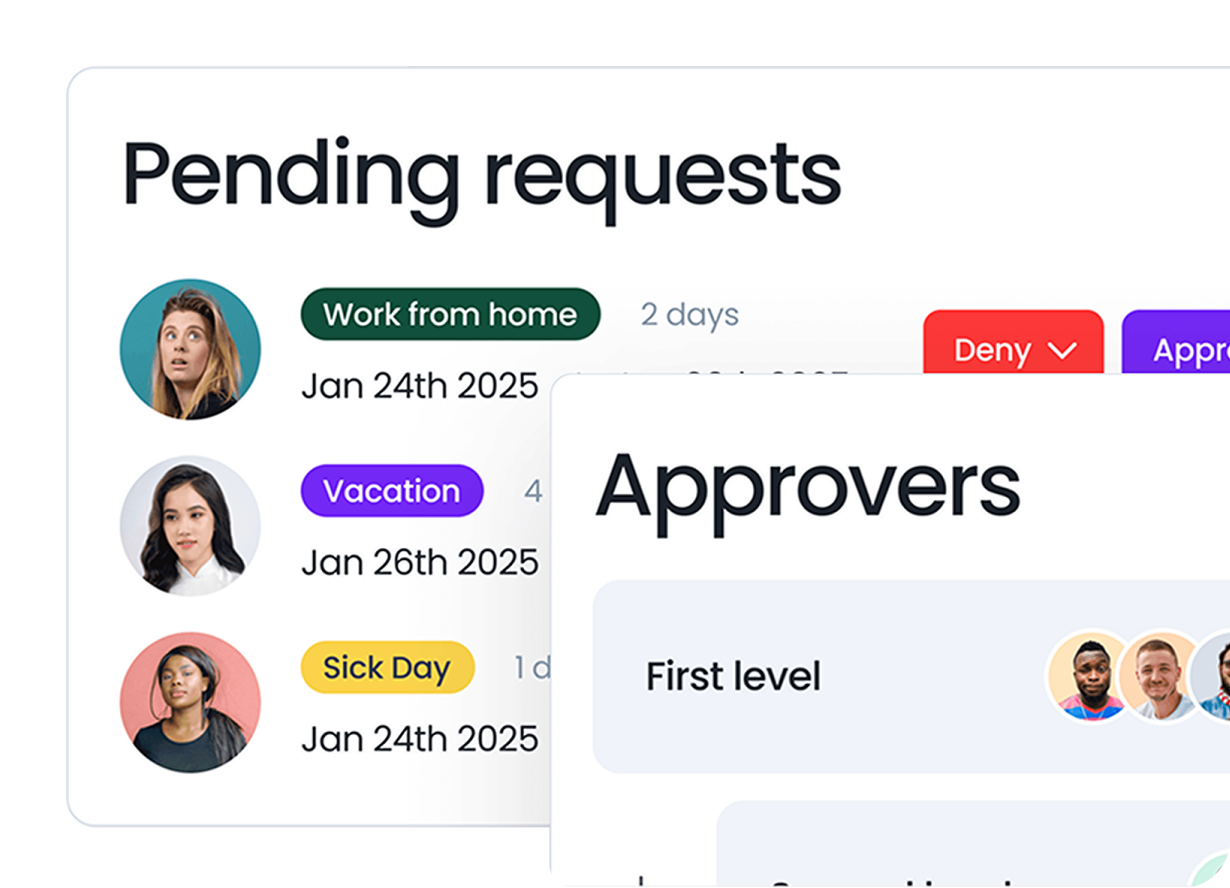Last updated on July 18, 2025
Paid Time Off (PTO) is an essential aspect of work-life balance, ensuring employees have the opportunity to take breaks, rest, enjoy, and rejuvenate. This article goes through the PTO landscape in Canada, exploring vacation, sick leave, maternity, and parental leave, paternity leave, and bereavement leave. By examining various aspects of PTO, we aim to shed light on the policies, trends, and experiences surrounding time off for Canadian workers.
Vacation
A Global Viewpoint: Comparing Vacation in Canada and the World
While living in Canada offers many advantages, a generous number of vacation days is not one of them. Although it ranks highly in terms of quality of life, Canada is among the worst countries in the world when it comes to mandatory paid vacation time. In fact, Canadian PTO laws guarantee only 10 days, which is less than half the number of vacation days compared to many other countries. The only country in the OECD with a worse record than Canada is the infamous ‘no-vacation nation’, the U.S., where workers aren’t guaranteed any paid leave.
![]()
Source: Leave Laws – Vacation Tracker
According to provincial laws, employees in the majority of provinces are typically limited to a maximum of 10 vacation days (2 weeks) during the initial years of employment with the same employer. However, in Saskatchewan, new employees enjoy the benefit of 15 days (3 weeks) of paid vacation.
Canadians Are Not Using All Their Allotted Vacation Time
According to a survey conducted by Maru Public Opinion, it was discovered that approximately 29% of employed Canadians utilized all of their allotted vacation days in 2022. In contrast, 17% confessed to not taking any vacation days at all. The majority, comprising 54%, took vacations to different extents.
Unused Vacation Days as a Global Phenomenon
A study conducted by Expedia across North America, South America, Europe, and Asia-Pacific reveals that Canadians are not alone in not using all their allotted vacation days. In fact, workers in Japan were the only ones to have used more vacation days than allotted in 2022. As the data indicates, Canada ranks among the worst OECD countries both in terms of days allotted and days used, beaten for the lowest spot only by Mexico and the U.S.
![]()
Do Canadians Feel Vacation-Deprived?
According to the same study, the phenomenon of “vacation deprivation” is present worldwide, affecting more than half of workers globally. Vacation deprivation occurs when employees dedicate excessive time to work and insufficient time to taking breaks and enjoying time off.
Based on the data presented above regarding vacation trends in Canada, it is evident that a significant number of Canadians have experienced vacation deprivation, with over half of them (57%) falling into this category. It may provide some consolation to Canadians to know that their situation is relatively better compared to many other countries, and it falls below the global average.

How Can Employers Help Reduce Vacation Deprivation?
One way to combat vacation deprivation is by making it easier for employees to see their available time off and feel encouraged to take it. Vacation Tracker gives teams the transparency they need: Everyone can view upcoming leaves on a shared calendar, check their balances, and submit requests in just a few clicks. For employers, it means clearer oversight and fewer missed opportunities for rest. When taking time off feels easy and supported, people are more likely to actually do it.
Want to see how it works?
Tracking Can Be
Learn how to manage time off without
confusion, delays, or admin headaches.

Sick Leave
Paid Sick Leave in Canada
The situation regarding paid sick leave is not much better than with mandatory vacation. Only two provinces guarantee it: Quebec (2 days) and British Columbia (5 days). Prince Edward Island also provides 1 day of paid leave, but only for employees who have been working for 5+ years. Federal laws grant employees 3 paid sick days. None of the provinces in Canada offer the recommended ten paid sick days in a calendar year, as suggested by advocacy organizations. On the other hand, Canadian law ensures that employees in federally regulated sectors receive up to 10 new days of paid sick leave.
The duration of legally mandated unpaid sick leave varies across provinces. (Only for standard sick leave, any sort of absences for long-term leave, critical illness, injury leave, or compassionate care leave are not included.)
![]()
Source: Leave Laws – Vacation Tracker
Waiting Period for Sick Days
In Canada, employers have the discretion to impose a waiting period for sick leave benefits. Typically, the legally required waiting period in most provinces is either one month (30 days) or three months (90 days), except Ontario, where it is set at 14 days. Notably, the laws in Nova Scotia do not mention any specific waiting period for sick leave.
![]()
Source: Leave Laws – Vacation Tracker
Want to see how other Canadian companies are managing PTO effectively?
SBA Lawyers switched to Vacation Tracker to get a clearer view of team availability and reduce the back-and-forth of manual tracking. Read their success story to see how better visibility can make a real difference: SBA Lawyers Case Study
Maternity and Parental Leave
Duration of Maternity Leave Worldwide: Canada Among the Best
In contrast to vacation and sick days, Canada’s employment legislation displays a more generous approach to maternity leave policies. The country firmly positions itself among the top performers worldwide, providing a total of 50 weeks for mothers (15 weeks of maternity leave and 35 weeks of parental leave). Notably, countries with the longest maternity leave surpass the one-year mark: Estonia leads the way with a maximum of 140 days of maternity leave and 435 days of parental leave (equivalent to 82 weeks), followed by Bulgaria with 410 days (58.6 weeks), and Sweden with 250 days of maternity leave and 150 days of parental leave (55.7 weeks).
![]()
Source: Leave Laws – Vacation Tracker
To learn more, read our article dedicated to maternity leave in Canada.
Paternity Leave
‘Daddy Days’ in Canada: A Step Towards Gender Equality
Canada also has a generous paternity leave policy, which is a part of parental leave and is shared between mother and father. However, as of 2019, fathers are guaranteed 5 weeks of their own, commonly referred to as ‘daddy days.’ These additional 5 weeks cannot be transferred to the mother, as part of a gender equality campaign by the Canadian government aiming to encourage fathers to take more parental leave, thus creating a ‘use-it-or-lose-it’ scenario.
Check out our article dedicated to paternity leave in Canada to learn more.
Paternity Leave Growing in Popularity Around the World
The provided chart lists countries that offer the longest paternity leave worldwide. It’s important to note that the duration of paternity leave can be extended even further if fathers choose to take a larger portion of the overall parental leave. The number of weeks mentioned represents the leave specifically reserved for fathers (a separate minimum that cannot be transferred to mothers). Japan offers by far the longest paternity leave in the world, providing a full year (52 weeks) of absence from work.
![]()
Source: Leave Laws – Vacation Tracker
Quebec as a Trailblazer
The first province to introduce mandatory paternity leave was Quebec in 2006. In the five years following the implementation of the policy, the percentage of fathers taking paternity leave increased significantly, soaring from 22% to 84%. This remarkable rise stands in stark contrast to the mere 11% of fathers in the rest of Canada who opted for paternity leave during the same period. The following chart indicates the gap has narrowed to some extent, but Quebec remains significantly ahead of the rest of Canada.
![]()
Source: Statistics Canada, General Social Survey – Family, 2017.
Bereavement Leave
Bereavement Leave Policies Across Canadian Provinces
Bereavement leave is available to workers in most Canadian jurisdictions. All provinces and territories (except Nunavut) have included a bereavement leave policy in their employment legislation. Generally, employers must provide at least 3 days of unpaid leave, with the exception of Ontario where it is set to 2 days. Some provinces guarantee paid bereavement leave: Quebec (2 days), Prince Edward Island (1 day), and Newfoundland and Labrador (1 day).
![]()
Source: Leave Laws – Vacation Tracker
Wrapping Up
In conclusion, the analysis of Paid Time Off (PTO) in Canada reveals a mixed landscape. While Canadians face challenges in terms of vacation and sick leave policies, there are positive strides in parental leave, with a growing emphasis on gender equality. Continued efforts to enhance PTO offerings and ensure equitable access to time off remain essential for fostering a healthy work culture in Canada.
How Vacation Tracker Supports PTO Management in Canada
Canada’s PTO policies can be complex, especially with variations across provinces, limited access to paid sick leave, and low vacation usage rates. For growing teams, these challenges often translate into scattered tracking methods, inconsistent policy enforcement, and poor visibility into who’s off and when.
Vacation Tracker helps solve these issues by centralizing all types of leave, vacation, sick days, parental leave, bereavement, and more, into one easy-to-use platform. Employees can request time off directly through Slack, Microsoft Teams, or Google Workspace, making it simple and accessible no matter where they work. Managers get real-time visibility into team availability, automated leave balance calculations, and clear records for compliance and reporting.
Whether your team operates in one province or across many, Vacation Tracker helps ensure that everyone gets the time off they’re entitled to, without the administrative burden.

Uros Vucendic
After many years of working as a programmer, Uros has finally returned to his true passion, which would be writing, as a content writer in Vacation Tracker. Human words surely bring more beauty and poetry than codes do, so one could say that today, at last, he is content as a writer. A content writer.




